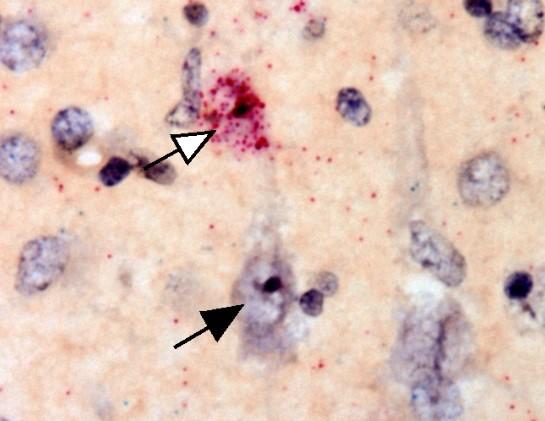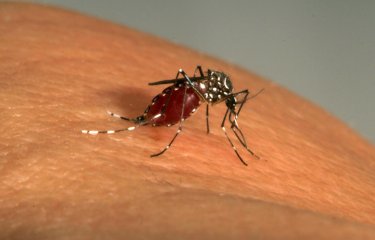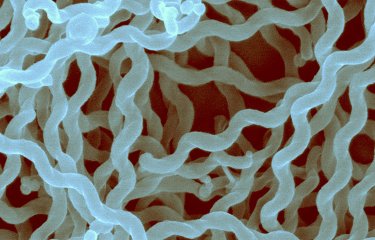The Institut Pasteur's Pathogen Discovery Laboratory and the neuropathology laboratory at Pitié-Salpêtrière Hospital set out to identify pathogens in fatal cases of encephalitis of unknown etiology. In two immunosuppressed patients, the Umbre virus (genus Orthobunyavirus) was identified. This virus infects neurons in the cerebral cortex, the spinal cord and the liver. The discovery of a novel arbovirus responsible for encephalitis, and its existence in France, holds particular interest for public health.
Human encephalitis is a syndrome whose cause remains unknown in more than a third of cases. Any new identification of a pathogen responsible for encephalitis can therefore improve diagnostic efficacy and medical treatment for patients.
The Pathogen Discovery Laboratory, led by Marc Eloit at the Institut Pasteur, together with several teams of scientists from the Institut Pasteur and the neuropathology laboratory at Pitié-Salpêtrière Hospital led by Danielle Seilhean, set out to identify pathogens in fatal cases of encephalitis of unknown etiology based on brain tissue analysis using high-throughput sequencing. The sequencing was performed with equipment from the Institut Pasteur's Biomics platform.
In two immunosuppressed patients, the Umbre virus, belonging to the genus Orthobunyavirus, was identified. The virus infects neurons in the cerebral cortex (see image), the spinal cord and the liver of patients.
The Umbre virus was initially described in the 1970s in Culex mosquito populations in the Asia Pacific region, but it had not previously been isolated in mammals (including humans) or detected in Europe.

The infection of two French patients with the Umbre virus – one lived in the Occitanie region and had never traveled outside mainland France, and the other had been on a cruise in the Mediterranean before the symptoms emerged – prompted the scientists to search for the origin of the contamination in mosquitoes. Their investigation, carried out in partnership with the French Agricultural Research Centre for International Development (CIRAD) in Montpellier and the Interdepartmental Alliance for Mosquito Control on the Mediterranean Coast (EID), resulted in the identification of sequences from the genus Orthobunyavirus that are closely related to the Umbre virus in Culex mosquitoes in the Camargue.
A serological survey using a test developed at the Institut Pasteur on a population from southern France composed of approximately 300 control individuals and around 20 encephalitis cases did not reveal an antibody response to the Umbre virus. While this result suggests that the frequency of infection in the general population is very low, it does not reflect the risk for immunosuppressed individuals.
The discovery of a novel arbovirus responsible for encephalitis, and its existence in France, holds particular interest for public health and emphasis the synergy between clinicians and microbiologists in pathogen discovery
Source
Identification of Umbre Orthobunyavirus as a Novel Zoonotic Virus Responsible for Lethal Encephalitis in 2 French Patients with Hypogammaglobulinemia, Clinical Infectious Diseases, June 9, 2020.
Philippe Pérot,1 Franck Bielle,2,3 Thomas Bigot,4, Vincent Foulongne,5 Karine Bolloré,5 Delphine Chrétien,1 Patricia Gil,6,7 Serafín Gutiérrez,6,7, Grégory L’Ambert,8 Karima Mokhtari,2,3 Jan Hellert,9 Marie Flamand,9 Carole Tamietti,9 Muriel Coulpier,10 Anne Huard de Verneuil,10 Sarah Temmam,1, Thérèse Couderc,11 Edouard De Sousa Cunha,2 Susana Boluda,2,3,12, Isabelle Plu,2,3,12 Marie Bernadette Delisle,13 Fabrice Bonneville,14 David Brassat,15, Claire Fieschi,16 Marion Malphettes,16 Charles Duyckaerts,2,3 Bertrand Mathon,3,17, Sophie Demeret,18 Danielle Seilhean,2,3,12 and Marc Eloit1,19
1. Pathogen Discovery Laboratory, Institut Pasteur, Paris, France,
2. Raymond Escourolle Neuropathology Department, AP-HP-Sorbonne, Pitié-Salpêtrière University Hospital, Paris, France,
3. Sorbonne University, Brain Institute (ICM; INSERM, UMRS 1127; CNRS, UMR 7225), Paris, France,
4. Bioinformatics and Biostatistics Hub–C3BI, Institut Pasteur, USR 3756, CNRS, Paris, France,
5. Pathogenesis and Control of Chronic Infections, INSERM, University of Montpellier, French Blood Service, Montpellier University Hospital, Montpellier, France,
6. CIRAD, UMR ASTRE, Montpellier, France,
7. ASTRE, CIRAD, INRA, University of Montpellier, Montpellier, France,
8. EID Méditerranée, Montpellier, France,
9. Structural Virology Unit, Institut Pasteur, CNRS UMR 3569, Paris, France,
10. UMR Virologie, ANSES, ENVA, INRAE, UPE, Alfort National Veterinary School, Maisons-Alfort, France,
11. Biology of Infection Unit, Institut Pasteur, INSERM U1117, Paris, France,
12. CNR ATNC (Reference Center for Nonconventional Transmissible Agents), Laboratory and Neuropathology Network for the Surveillance of Creutzfeldt-Jakob Disease, Santé Publique France, AP-HP, Paris, France,
13. Neuropathology Laboratory, University Laboratory of Pathological Anatomy and Cytology, Toulouse University Hospital, Toulouse III – Paul Sabatier University, Toulouse, France,
14. Department of Neuroradiology, Toulouse University Hospital and UMR 1214 ToNIC, University of Toulouse, INSERM, Toulouse, France,
15. CRC-SEP, Neurosciences Pole, Toulouse University Hospital and UMR 1043, University of Toulouse III, Toulouse, France,
16. Department of Clinical Immunology, Saint-Louis Hospital, Paris Public Hospital Network (AP-HP), University of Paris, Paris, France,
17. AP-HP, Pitié-Salpêtrière Charles-Foix University Hospital, Department of Neurosurgery, Paris, France,
18. Department of Neurology, Neuro ICU, Groupe Hospitalier Pitié-Salpêtrière, AP-HP, Paris, France,
19. Alfort National Veterinary School, Maisons-Alfort, Maisons-Alfort, France
This study is part of the priority scientific area Emerging infectious diseases of the Institut Pasteur's strategic plan for 2019-2023.






